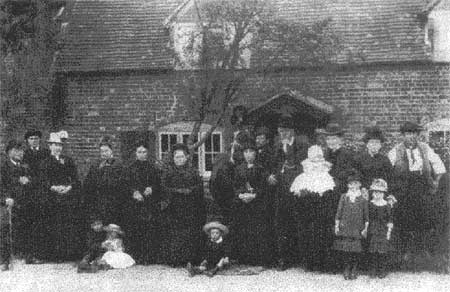|
Jill Saunders writes:
My father John Hubert Saunders, of the Saunders family, Butchers Farm, Braishfield wrote extracts of memories of the community during the Second World War and after, for a village newsletter during the period 1988-1989. Some of these have come into my possession since his death in 1994, and are reproduced here.
My earliest memory is of my grandfather's enormous pig. Her name was Betsy and she was so big the doorway to her sty had to be enlarged to allow her to enter. Betsy would frighten the daylights out of me at feeding time when she would stand on her hind legs and put her front feet on the palisade around her sty.
As the food got nearer she would squeal louder and get more exited and jump up and down to the point where I was convinced she would leap out of the sty and consume anything, possibly even me, a small boy of 3 years old.
Almost everyone in the village kept some sort of livestock ranging from chickens, geese, ducks, pigs, and goats to rabbits. They consumed all the leftovers from the house and garden and provided much-needed sources of eggs, meat or milk to supplement the wartime rations of Britain.
Most of the animals required for meat, such as chickens or rabbits were slaughtered by the householder, but the pigs were usually attended to by the Vane brothers from Timsbury, who would cycle along to the house and despatch and dismember the hapless animal.
My most vivid memory of the war concerns the searchlight based at Casbrook Common. There were several of the searchlights positioned around the area, mounted on trailers so they could be moved around to create the illusion that there were more of them than there actually were. They could fool the German bombers into believing they were surrounding a large town when in fact they were in open country.
At the end of the war we held victory celebrations on the recreation ground with fireworks, and the letters V E and VJ some three or four feet high were constructed in wire, straw and sacking then soaked in paraffin and ignited.
Many American troops were stationed in the area at this time and all the waste food from the army camps was placed in large tubs and delivered to pig keepers by two very large coloured GIs in an equally large and impressive American truck. These tubs of pigswill were known as Wembley pudding although I never discovered why.
I remember starting school at Braishfield where the infant teacher Mrs Penfold could bring tears to your eyes with the edge of a ruler. There was of course the annual nit inspection and various welfare handouts such as powdered milk and drinking chocolate which was I believe, a gift from the American or Canadian Government.
We were all told to take a large jar to school into which was dispensed a measured amount to take home. Most of it was consumed on the way home by continually dunking a moistened finger into the contents.
Free school milk was distributed each morning in 1/3 pint bottles sealed with a cardboard cap into which you inserted your index finger. We were each issued with a straw, which we would place in the bottle and then blow down to create a mass of bubbles.
In the summer the milk was frequently sour and in the winter it was so cold you could barely drink it.
Our milk at home was delivered daily and ladled out from a churn into bowls and other receptacles. This dairy operated from Awbridge and a few years later Mr Arthur Watts of Crookhill Farm started deliveries with a most unusual three-wheeled vehicle which could be seen each day putt-putt-ing around the village.
My memories just after the war concern the many characters in the village. There were quite a few tradesmen, such as Henry Travis who was the local carpenter, wheelwright and undertaker who had a workshop in Newport lane.
Others were George Parsons who was a carpenter and builder, and the Topp brothers from Timsbury who built many houses in Braishfield and the surrounding villages.
Dennis Harrington lived in Newport lane and possessed an immaculate Ariel Red Hunter motorcycle and in his spare time repaired bicycles etc.
The Newport Inn was kept by Alec and Elsie Cottle who also possessed one of the few telephones in the village.
The Wheatsheaf Inn was kept by Jack Bailey, and the Dog and Crook was kept by Ted and Mildred Monger who were my Grandparents. This was the centre of much black market trade that existed towards the end of the war.
It was also the venue for the Boxing Day hunt, which assembled there every year because in those days the Hursley Hunt Kennels were at Dores Lane under the supervision of Mr Gosden. 
The Saunders family from the 1880's.
| |


